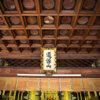Tamamushi Shrine
The Tamamushi Shrine is a shrine that was created during the Asuka period and is housed in Hōryū-ji Temple. It has been designated as a national treasure.

The shrine is a roofed structure used to house objects of worship, such as Buddhist statues, indoors. The Tamamushi Shrine is designed to resemble the exterior of an actual Buddhist temple building.
This shrine is approximately 2.3 meters tall and made of cypress wood, although camphor wood is used exclusively for the parts carved with lotus petals. The entire surface is lacquered, and the doors and paneling are decorated with Buddhist paintings using red, yellow, and green pigments.
Believed to be from the 7th century, this shrine at Hōryū-ji Temple in Nara is made of wood and lacquered. It is shaped like a palace, with wooden corner posts at each corner, and consists of three parts: the base, the platform for placing Buddhist statues or objects (the sumiza), and the pedestal.
The long horizontal beams, pillars, and frames are adorned with openwork metal fittings made of gilded bronze. The name of the shrine comes from the iridescent wings of the jewel beetle, which were once laid under the metal fittings of the palace section.

The walls of the Tamamushi Shrine are made of black lacquered wood, and the patterns are drawn using a combination of Mitsuda-e (a type of oil painting) and lacquer.
On the front of the central altar is an offering scene, on the sides are scenes from the life of Buddha, and on the back is a painting of Mount Meru.
On the front door of the palace section are images of celestial beings, on the side doors are images of bodhisattvas, and on the back is a depiction of the world of immortals.
The Tamamushi Shrine is an important national treasure representing Japanese craft techniques of the Asuka period and is also a valuable art piece for its rare Buddhist paintings.

















